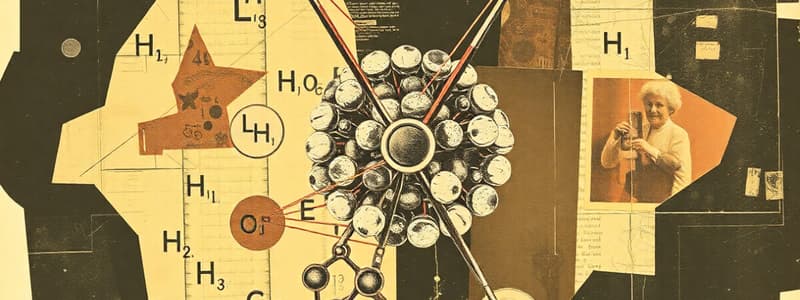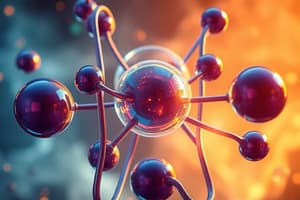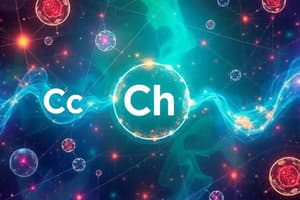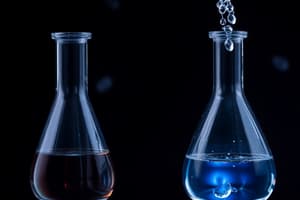Podcast
Questions and Answers
Which properties must matter possess? (Select two answers)
Which properties must matter possess? (Select two answers)
- Definite shape
- Volume (correct)
- Mass (correct)
- Energy
What type of variable is manipulated by the researcher in an experiment?
What type of variable is manipulated by the researcher in an experiment?
- Control variable
- Constant variable
- Dependent variable
- Independent variable (correct)
Why is it crucial to control all factors in an experiment except for the independent variable?
Why is it crucial to control all factors in an experiment except for the independent variable?
- To keep the experiment financially affordable for the research lab
- To ensure that any changes are due to changes in the independent variable only (correct)
- To complete the experiment faster
- To guarantee that the results support your hypothesis
What is the primary objective of conducting an experiment?
What is the primary objective of conducting an experiment?
Chemical properties can be defined as _________________ while physical properties can be defined as _________________.
Chemical properties can be defined as _________________ while physical properties can be defined as _________________.
What is the most effective way to determine the volume of an irregularly shaped object?
What is the most effective way to determine the volume of an irregularly shaped object?
What is the correct formula for calculating density?
What is the correct formula for calculating density?
Which object is most likely to float in water, given its density?
Which object is most likely to float in water, given its density?
In the analogy of a hotel, the hotel rooms are compared to what?
In the analogy of a hotel, the hotel rooms are compared to what?
Which energy level can hold the most electrons?
Which energy level can hold the most electrons?
How many electrons can fill the p orbital sublevel?
How many electrons can fill the p orbital sublevel?
After electrons completely fill the 2p orbitals, where will the next electron go?
After electrons completely fill the 2p orbitals, where will the next electron go?
How many electrons are present in the atom with the electron configuration: 1s2 2s2 2p2?
How many electrons are present in the atom with the electron configuration: 1s2 2s2 2p2?
What was the primary goal of organizing the elements into an ordered table?
What was the primary goal of organizing the elements into an ordered table?
What phenomenon occurs in an atom when we perceive color in a lit room?
What phenomenon occurs in an atom when we perceive color in a lit room?
What does the period number in the modern Periodic Table indicate?
What does the period number in the modern Periodic Table indicate?
What property differentiates one element from another?
What property differentiates one element from another?
Which of the following mixtures can be described as homogeneous?
Which of the following mixtures can be described as homogeneous?
What transition occurs when a solid becomes a liquid upon heating?
What transition occurs when a solid becomes a liquid upon heating?
Which is true regarding water (H2O) and hydrogen peroxide (H2O2)?
Which is true regarding water (H2O) and hydrogen peroxide (H2O2)?
In a chemical reaction, if the mass before the reaction is 5.6 g and after is also 5.6 g, what principle is illustrated?
In a chemical reaction, if the mass before the reaction is 5.6 g and after is also 5.6 g, what principle is illustrated?
An atom's mass number is determined by which of the following?
An atom's mass number is determined by which of the following?
What happens when an atom loses electrons?
What happens when an atom loses electrons?
Which of the following best describes isotopes of an element?
Which of the following best describes isotopes of an element?
Which part of an atom contains protons and neutrons?
Which part of an atom contains protons and neutrons?
What characterizes the charge of an atom with 33 protons and 31 electrons?
What characterizes the charge of an atom with 33 protons and 31 electrons?
What is meant by electrons having quantized energy?
What is meant by electrons having quantized energy?
What is the correct layering order of balsamic vinegar, sugar, and olive oil based on their densities?
What is the correct layering order of balsamic vinegar, sugar, and olive oil based on their densities?
Why is Thomson’s plum-pudding model considered incorrect?
Why is Thomson’s plum-pudding model considered incorrect?
What term refers to the area around the nucleus where electrons are found?
What term refers to the area around the nucleus where electrons are found?
Flashcards
What is matter?
What is matter?
Anything that has mass and volume.
What is the independent variable?
What is the independent variable?
The variable that is intentionally changed by the researcher. Basically, the ‘cause’.
Why are controlled experiments important?
Why are controlled experiments important?
A controlled experiment keeps all other factors constant, except for the independent variable. It makes it easier to isolate the effect of the independent variable on the dependent variable.
What is the main goal of an experiment?
What is the main goal of an experiment?
Signup and view all the flashcards
What's the main difference between chemical and physical properties?
What's the main difference between chemical and physical properties?
Signup and view all the flashcards
How do you typically identify physical properties?
How do you typically identify physical properties?
Signup and view all the flashcards
What is the volume of a substance?
What is the volume of a substance?
Signup and view all the flashcards
What is density?
What is density?
Signup and view all the flashcards
What are orbitals?
What are orbitals?
Signup and view all the flashcards
What is the order of orbital filling within an energy level?
What is the order of orbital filling within an energy level?
Signup and view all the flashcards
What determines the energy level of an orbital?
What determines the energy level of an orbital?
Signup and view all the flashcards
How many electrons can an energy level hold?
How many electrons can an energy level hold?
Signup and view all the flashcards
How many electrons can the second energy level (n=2) hold?
How many electrons can the second energy level (n=2) hold?
Signup and view all the flashcards
What are p orbitals?
What are p orbitals?
Signup and view all the flashcards
How many electrons can fit in the p sublevel?
How many electrons can fit in the p sublevel?
Signup and view all the flashcards
How is the modern periodic table organized?
How is the modern periodic table organized?
Signup and view all the flashcards
Density
Density
Signup and view all the flashcards
Solid
Solid
Signup and view all the flashcards
Liquid
Liquid
Signup and view all the flashcards
Gas
Gas
Signup and view all the flashcards
Melting
Melting
Signup and view all the flashcards
Evaporation
Evaporation
Signup and view all the flashcards
Homogeneous Mixture
Homogeneous Mixture
Signup and view all the flashcards
Heterogeneous Mixture
Heterogeneous Mixture
Signup and view all the flashcards
Distillation
Distillation
Signup and view all the flashcards
Compound
Compound
Signup and view all the flashcards
Atom
Atom
Signup and view all the flashcards
Atomic Number
Atomic Number
Signup and view all the flashcards
Isotopes
Isotopes
Signup and view all the flashcards
Ion
Ion
Signup and view all the flashcards
Quantized Energy Levels
Quantized Energy Levels
Signup and view all the flashcards
Study Notes
Multiple Choice Questions: Matter, Atoms, and the Periodic Table
- Matter: Matter possesses mass and volume.
- Controlled Experiments: A controlled experiment ensures that observed changes are due to the independent variable only, by keeping all other factors constant. The independent variable is intentionally changed, while the dependent variable is measured.
- Experiment Goal: Experiments aim to test hypotheses and determine if results support or refute them.
- Chemical vs. Physical Properties: Chemical properties describe how a substance changes when it undergoes a chemical reaction. Physical properties can be observed without changing the substance’s composition.
- Identifying Physical Properties: Use your senses (sight, smell, touch, taste - use with caution) to identify physical properties.
- Volume: Volume is the amount of 3D space a substance occupies.
- Density: Density (d) is calculated as mass (m) divided by volume (V): d = m/V. Units are typically g/mL or g/cm³.
- Measuring Volume of Irregular Shapes: Use water displacement to determine the volume of an irregularly shaped object.
- Floating/Sinking: An object floats if its density is less than the density of the liquid it is placed in. Density of water is 1 g/mL (or 1 g/cm³).
- Density and Layering: Substances with different densities will layer in a container, if not mixed, from highest density at the bottom to lowest at the top.
- States of Matter: Liquids have indefinite volume, gases also have indefinite volume. Solids have definite volume and shape.
- Phase Changes: The correct order of state transitions from coldest to hottest: solid (melting) → liquid (vaporization) → gas.
- Mixtures: A homogeneous mixture has a uniform composition throughout, whereas a heterogeneous mixture does not. Air is a homogeneous mixture.
- Separation Methods: Distillation separates substances based on differences in boiling points.
- Compounds: Compounds have fixed compositions, where elements combine in specific ratios. Their components cannot be physically separated.
- Compounds vs. Mixtures: Compounds have fixed ratios of elements and cannot be separated physically, unlike mixtures.
- Law of Conservation of Matter: The mass of reactants equals the mass of products in a chemical reaction.
- Atomic Structure: Electrons are negatively charged and occupy orbitals outside the nucleus, which contains positively charged protons and neutrons.
- Rutherford's Experiment: Discovered the nucleus containing positive charges in an atom.
- Neutral Atoms: Neutral atoms have an equal number of protons and electrons.
- Atomic Mass Number: Defined as the sum of protons and neutrons.
- Elements: Elements are differentiated by their atomic number (number of protons).
- Isotopes: Isotopes of an element have the same number of protons but different numbers of neutrons.
- Ions: Ions result from gaining or losing electrons. Cations are positively charged; anions are negatively charged.
- Quantized Energy & Electron Cloud: Electrons exist at specific energy levels and cannot be on levels between them; this area where electrons orbit is called the electron cloud.
- Periodic Table Arrangement: Elements are arranged by increasing atomic number.
- Periodic Table Organization: The periodic table groups elements with similar properties.
- Electron Configurations: These represent the arrangement of electrons in different energy levels and sublevels. This is related to color in lights.
- Valence Electrons & Energy Levels: The number of valence electrons and energy level determine an element's position in the periodic table.
Studying That Suits You
Use AI to generate personalized quizzes and flashcards to suit your learning preferences.




